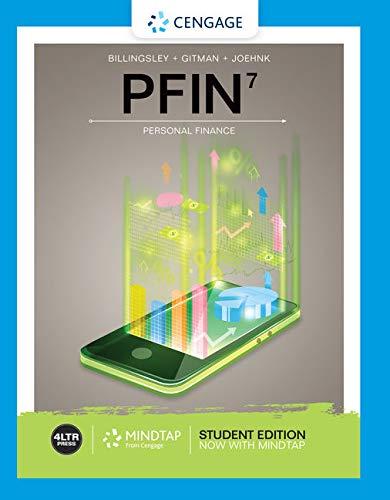
Concept explainers
Diversifiable and Nondiversifiable Risks In broad terms, why is some risk diversifiable? Why are some risks nondiversifiable? Does it follow that an investor can control the level of unsystematic risk in a portfolio, but not the level of systematic risk?
Systematic risk is essential for the complete market or segment. It is otherwise called market risk or undiversifiable risk that has an overall impact. This risk is unavoidable and not predictable. Here, hedging and appropriate strategy of asset allocation works out. While, mitigation with diversification is not possible.
Systematic risk states how one investment supports to the total aggregate risk of business’s financial funding.
Unsystematic risk is otherwise called the diversifiable, residual, non-systematic or specific risk. The proportion of a corporation’s total or aggregate risk which can be reduced through diversified asset portfolio.
Explanation of Solution
The investor can control risks using the following ways:
Yes, investors can control unsystematic risks. However, they cannot control systematic or market risks.
Diversifiable risks are unsystematic risks. Here, the total aggregate risk is decreased while using diversified asset portfolio. For example, oil spill and product liability of one manufacturer (in specific) can be reduced through diversification.
Systematic risks are non-avoidable and not diversifiable. They can be mitigated using diversification. These risks are unavoidable as it applies to complete segment. For example, Supreme Court decision (market related) and rise in interest rate is not avoidable. Also, this risk cannot be diversified.
Want to see more full solutions like this?
Chapter 11 Solutions
CORP FIN (LL)+CONNECT+PROCTORIO+180
- 4. A company has $100,000 in assets and $50,000 in liabilities. What is its equity? Need a helpful..???arrow_forward4. A company has a debt-to-equity ratio of 1:2. If debt is $200,000, what is equity?arrow_forward9. If a company's current ratio is 2 and its current liabilities are $50,000, what are its current assets?no chatgpt???arrow_forward
- 5. Calculate the return on equity (ROE) for a company with net income $150,000 and equity $750,000.arrow_forward6. What is the price of a bond with face value $1,000, coupon rate 8%, and market interest rate 10%?arrow_forward9. A company has fixed costs $50,000, variable costs $10/unit, and sells products at $20/unit. What is the break-even point?arrow_forward
- 8. Calculate the weighted average cost of capital (WACC) for a company with 60% equity (cost 12%) and 40% debt (cost 8%). no gpt ..???arrow_forward8. Calculate the weighted average cost of capital (WACC) for a company with 60% equity (cost 12%) and 40% debt (cost 8%). Need a helpful..??arrow_forward3. If a company's net income is $100,000 and it has 10,000 shares outstanding, what is the earnings per share (EPS)? Correctly answer..???arrow_forward
- 10. If a stock's dividend yield is 5% and stock price is $100, what is the annual dividend payment? no gpt..???arrow_forward8. A stock has a beta of 1.2 and the market return is 10%. If the risk-free rate is 2%, what is the expected return? need a ai ..???arrow_forwardA corporation buys on terms of 2/8, net 45 days, it does not take discountes, and it actually pays after 62 days, what is the effective annual percentage cost of its non-free trade credit? Use a 365-day year) keep to the 6th decimal place for accuracyarrow_forward
 EBK CONTEMPORARY FINANCIAL MANAGEMENTFinanceISBN:9781337514835Author:MOYERPublisher:CENGAGE LEARNING - CONSIGNMENT
EBK CONTEMPORARY FINANCIAL MANAGEMENTFinanceISBN:9781337514835Author:MOYERPublisher:CENGAGE LEARNING - CONSIGNMENT Financial Reporting, Financial Statement Analysis...FinanceISBN:9781285190907Author:James M. Wahlen, Stephen P. Baginski, Mark BradshawPublisher:Cengage Learning
Financial Reporting, Financial Statement Analysis...FinanceISBN:9781285190907Author:James M. Wahlen, Stephen P. Baginski, Mark BradshawPublisher:Cengage Learning Intermediate Financial Management (MindTap Course...FinanceISBN:9781337395083Author:Eugene F. Brigham, Phillip R. DavesPublisher:Cengage Learning
Intermediate Financial Management (MindTap Course...FinanceISBN:9781337395083Author:Eugene F. Brigham, Phillip R. DavesPublisher:Cengage Learning Pfin (with Mindtap, 1 Term Printed Access Card) (...FinanceISBN:9780357033609Author:Randall Billingsley, Lawrence J. Gitman, Michael D. JoehnkPublisher:Cengage Learning
Pfin (with Mindtap, 1 Term Printed Access Card) (...FinanceISBN:9780357033609Author:Randall Billingsley, Lawrence J. Gitman, Michael D. JoehnkPublisher:Cengage Learning




